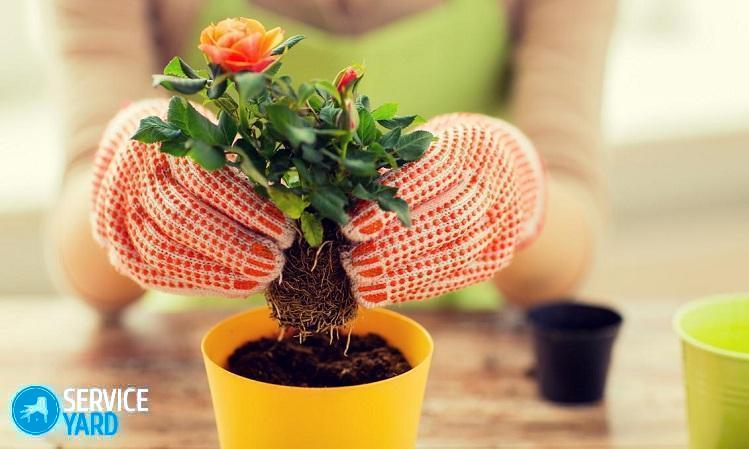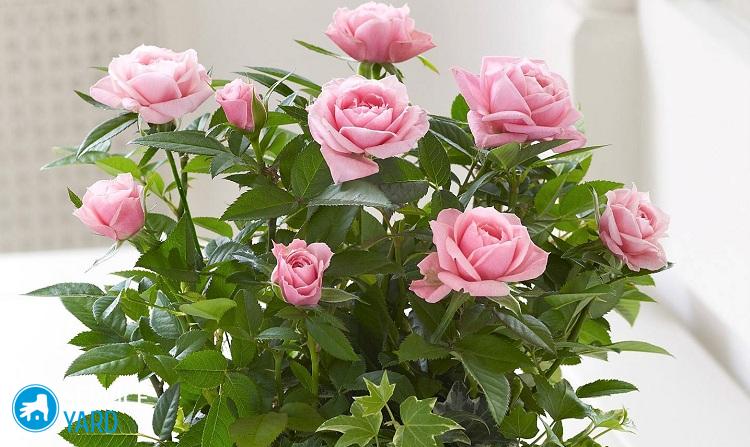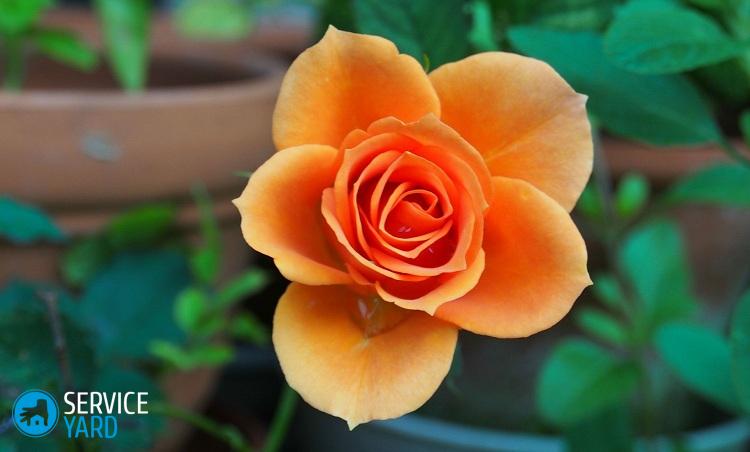How to care for roses in a pot from a store?

Rose is a magnificent flower, a queen among the whole variety of plant varieties and species, and enjoys special love and deserved popularity. If you want to always enjoy the beautiful view, then start house roses at home. This is a wonderful decoration of the house, because the flowers delight us with its magnificent view and pleasant freshness. It is worth noting that this type of plant is considered delicate and demanding, therefore, information on how to care for roses in a pot from a store at home will not be out of place. In this article we will share with you how to feed roses in an apartment, how to care for a decorative tea rose in a pot, for bush and potted roses.
to contents ↑Types of home roses in pots
To begin with, it is worth identifying existing plant varieties. Most often, undersized species are found on sale, which we will consider in more detail below.
Polyanthus
This flower is derived from the crossing of two mini roses - Chinese and multi-flowered. Here is a brief description of this type of plant:
- Rose bushes reach a height of 25-50 cm.
- The bushes are quite thick, but compact.
- The flowers do not have an aroma, and are quite small in size. The diameter of roses is 3-5 cm.
- Most often, the color of the petals has the following color: red, white, lilac, pink.
- Polyanthus roses bloom for a long time and are very plentiful.
- Flowers can be simple, semi-double and even densely double.
Bengal roses
Another name for this variety of flowers is Indian or Chinese. These are not wild roses; their appearance is most likely due to artificial selection and cultivation. Type characteristic:
- In length, the bush can reach 50 cm.
- Flowers can be single or have 2-3 buds in an inflorescence.
- Repeated flowering since July is continuous.
- Roses of this species are semi-double and double.
- The color of the petals is the most diverse. The exception is yellow, which is not found.
- The fragrance of the plant is weak or not at all.
- Bengal flowers are thermophilic plants.
- Leaf blades are small and narrow.
Miniature
These roses are the most popular among flower lovers. What characterizes this type of plant? Features of miniature colors:
- Flowers and leaves of small size.
- A wide range of colors and colors of petals.
- The length of the bush does not exceed 30 cm.
- The rose blooms for a long time and repeatedly. But there are also once flowering varieties.
- Shoots have a branched and thin structure.
- Miniature roses can be planted at home in pots, but also used outdoors on the open ground.
to contents ↑Important! Another common variety of indoor roses are Patio roses, which in fact belong to a variety of low-growing plants of the floribund group.
Rules for plant care immediately after purchase
So, you bought a houseplant and immediately think about how to care for roses in a pot from the store. Immediately after acquiring a flower, we recommend that you take a number of useful actions:
- You need to start with a thorough inspection of the bush. First of all, make an assessment of the general condition of the rose, and also check it for pests.After that, remove wilted and dry leaves, flowers or buds, branches.
- It is advisable to prune the plant. On each of the shoots, it is best to keep 4-5 buds.
- To protect the rose from pests, treat it with a special preparation. For example, Fitoverm.
- The plant will protect the fungicide solution from disease. An example of a drug might be Profit or Previkur.
- If the soil inside the plastic container is too moist and wet, you need to get the flower along with a lump of soil. This must be done extremely carefully and carefully. After that, place the plant on a piece of paper or a piece of cloth so that excess moisture is absorbed into it. Set the flower back in the container.
Where to put the pot?
Having completed all of the above procedures, you should place the rose in a non-hot place, in which there are no drafts and direct sunlight does not fall on the plant.
Important! To adapt to the conditions of your home, the plant will need several days. During this period, do not touch the rose, transplant.
Moisturizing
But, of course, the flower needs to be watered and sprayed in a timely manner. For these purposes, you can use a solution of "Zircon", which is a growth promoter. But you can not use it every day.
After 2-3 weeks, you can begin to transplant your room beauty.
to contents ↑Rose pot is an important attribute
The capacity in which your rose will grow plays a significant role, since the state of the flower depends on its suitable size. How to care for roses in a pot from a store, what nuances should be considered when choosing a new vessel for a flower? Several important aspects can be distinguished:
- Most often, plant pots are made of plastic or ceramic. Both options are suitable, but the first is cheaper and the second is more natural and “breathable”.
- The pot should have a hole in the bottom and on the pallet.
- Experienced flower growers are advised to choose elongated containers.
- A simple and quick way to select the desired pot size is as follows: measure two fingers wide and high from the previous vessel.
- But the most important requirement is the ratio of the root system of the rose to the size of the pot.
Important! The distance between the earthen lump with the roots of the flower and the walls of the vessel should be 2-3 cm.
- The best shape for the pot is a truncated cone, opened up. But the beautiful and stylish, at first glance, vessels in the form of a ball, in fact, are completely unsuccessful and even harmful to plants. This is due to the fact that in a wide part of the pot the soil is poorly ventilated, as a result, the roots can rot.
to contents ↑Important! It may seem that it is better to take a larger pot so that the plant is not crowded and there is a reserve for the future, but do not do this. An excessively large vessel will negatively affect the rose, as the soil will sour.
Transplanting a room rose
So, after buying a beautiful flower and adapting it to your home, you can start transplanting the plant. If you still do not know how to care for roses in a pot from a store at home, how to transplant a flower, then it's time to study this process in detail.
Materials
First of all, this requires:
- Substrate. It is best to purchase a land mixture in a specialized store or department. In addition, there you can buy soil designed specifically for a particular type of plant.
- Drainage. Materials for removing excess water and moisture can be: broken bricks or shards, pebbles, expanded clay, polystyrene.
- Pot. How to choose it, we described above.
- Sand or small stones 2-4 mm in size.
- Vermiculite. A mineral that helps protect roots from temperature extremes. And he holds the useful elements of fertilizers, which subsequently gradually gives the flower.
- Stimulants. Such substances are suitable - succinic acid, Ribav-extra and Zircon.
- “Fitosporin”.Optionally, you can add such a tool to protect the flower from soil diseases.
Do it yourself
It is not necessary to buy a ready-made earthen mixture. If possible, then an excellent substrate can be made independently. To do this, combine these ingredients in such proportions:
- Sod is one piece.
- Humus is one part.
- Coarse sand - ½ part.
Transfer
And now let's go directly to the process:
- We take out the flower from the container and inspect. If the roots of the rose filled the entire vessel, and even more so, if they began to twist, then they must be stirred up without fail.
Important! If this is not done, then undisturbed roots further develop much worse. Almost always with purchased copies, the root system goes in circles along the bottom of the container.
- Some gardeners are advised to rinse the roots and remove the substrate in which the flower was in the store. After that, soak them in a solution of stimulants. And others are of the opinion that such a procedure is unnecessary, and it will be quite simple to spray the roots of the plant with these means.
- If there are several bushes in a pot, we advise you to put them in separate vessels, so that later they will not constrain each other.
- We prepare the substrate. To do this, the soil that you purchased in the store must be mixed with sand and vermiculite. The proportion is this: for one liter of soil there is one handful of mineral and two handfuls of sand.
- We put drainage on the bottom of the pot.
- We immerse the rose with an earthen lump on the roots in a new vessel, fill it with prepared substrate.
- After that, we recommend that you cover the flower with a bag or jar to create a greenhouse environment. In this state, you need to keep the plant for at least ten days.
Important! But at the same time, of course, it is necessary to regularly ventilate and spray the rose, taking off the shelter for a while. You can cover the flower only after the leaves have dried.
- After ten days, the plant can no longer be covered.
to contents ↑Important! The transplantation of a room rose is subsequently carried out annually.
Important ingredients for room rose care
Not everyone knows how to care for roses in a pot from the store, and what factors affect the plant. In order not to overlook anything, let us dwell on each of the aspects of care in more detail.
Plant location
Beautiful and beautiful indoor roses are sun-loving plants. Therefore, for their placement, such cardinal points are optimal:
- Southwest.
- Southeast.
A window facing the suitable side will be the best place where it is advisable to put a flower.
Important! Although the plant loves the sun, this does not mean that it can be installed on the south side.
Excessive heat is detrimental to the flower: under its influence, rosebuds become smaller, the same thing happens with leaves. In addition, they begin to quickly fade and crumble. Another negative consequence is the drying out of the soil and overheating of the root system, and all due to the fact that the pots themselves become very hot in the heat.
Important! Overheating for indoor roses is extremely undesirable, so give preference to vessels of bright colors. Between May and September, wrap the pots with white paper - this will help protect the plant from the scorching sun.
Lighting role
Even from the school biology program, everyone knows information about the role of sunlight for plants. It is thanks to him that the flower lives, grows and blooms. Therefore, the question arises, how to care for roses in a pot from the store at home to provide them with the optimal amount of light? Here's what you need to do:
- In autumn and spring, provide your rose with an additional light source.
- You can extend daylight hours with a fluorescent lamp.
- After sunset, the lamp is turned on and left until midnight.
- Place the source at a distance of 30 cm from the top of the flower.
Important! Proper illumination of the plant can contribute to its flowering until the winter period.
Humidity level for a room rose
For this flower, moisture is of utmost importance. A delicate plant must be regularly and systematically sprayed. A spray bottle is best suited for these purposes, through which it is convenient to carry out refreshing procedures every week.
Important! Under bright sunlight, exclude drops of water on the leaves, because of this, burns may appear on them. Therefore, the best time for spraying is considered the evening.
Optimum humidity conditions can be created with the help of water containers, which must be installed between flower pots. During the evaporation process, water will help humidify the air.

Water the flowers correctly
Unfortunately, not everyone has information on how to care for roses in a pot from a store, and just water the plants from time to time. It seems that this is quite enough, and the main guideline is the drying of the soil. But in fact, irrigation is a very important part of care and has its own characteristics.
Important! Roses have a deep root system, and therefore, they need abundant watering.
There are several nuances to consider:
- Watering is especially important when the plant is in bloom.
- Watering the flower is best near the trunk, while trying not to wet the leaves.
- If you make a roller from the earth around the rose, then the water will not flow.
- The roots of roses do not absorb cold water, therefore the water must be heated. Moreover, the temperature for each season is separate. So, in the warm season from May to September, water from 18 to 24 degrees is considered the best indicator. The same temperature is recommended for watering during the period of active blooming of the rose: from the formation of buds to the end of their flowering. In the cooler months from October to April, water already has a lower temperature regime of 16-18 degrees.
- Do not water the flower with tap water, as it is oversaturated with calcium salts. In addition, tap water is hard and chlorinated.
Important! It is best to use filtered water for irrigation or standing for at least 24 hours. There is another option, how to irrigate a rose with quality water: freeze it in the refrigerator, and then let it melt and warm. Melt water is an excellent watering for the plant.
In general, there are two most common mistakes in watering indoor roses:
- They irrigate the plant often, but only a little. As a result, only moistening of the surface soil is carried out, and moisture does not reach the root system.
- Excessive watering. Abundant irrigation, which occurs quite often, will ultimately lead to the death of the flower.
Important! It is optimal to water roses once every 5-7 days. Irrigation must be plentiful in order to moisten the entire soil in the pot.
Top dressing
The next important aspect, how to care for roses in a pot from a store, is plant nutrition.
Important! Useful substances and microelements improve the general condition of the flower, contribute to its healthy growth, beautiful appearance, and also prevent various diseases.
It must be carried out according to the following rules:
- For the first time, dressing the indoor flower should be carried out in the spring, when there is a tying of the kidneys.
- The procedure can be performed no earlier than one month after a rose transplant.
- Do not fertilize diseased flowers.
- Top dressing is carried out regularly in the spring-summer period, with a frequency of once every two weeks.
Denote the main fertilizers and their effect on the flowers:
- Phosphorus. Favorably affects the growth of roots, shoots and can accelerate the onset of pores of flowering roses.
- Nitrogen. Positively affects the growth of stems and leaves of a houseplant, and also increases its mass.
- Potassium. It plays a special role in the formation of good buds and flowers, and also increases the plant's resistance to disease and drying out.
- Boron. This fertilizer acts on the leaves, or rather on their proper growth.
- Calcium. Protects shoots from wilting due to malicious viruses.
- The plant needs magnesium, manganese, and iron to maintain the saturated green color of the leaves of the bush. In addition, fertilizers prevent leaf fall early.
Pruning plants
How to care for roses in a pot from a store at home, so that the bush has a beautiful and magnificent shape, while it is maximally dotted with beautiful flowers? Such a result cannot be achieved if the plant is not trimmed.
Important! The optimal time for pruning is considered to be early spring, because it is advisable to carry out the procedure before the start of the active growth of room roses.
The procedure includes the following steps:
- First of all, they remove the flower from underdeveloped and weak stems, as well as interwoven branches.
- Leave about five strong and strong shoots on the bush. Their length should be medium.
- Excessively long shoots must be shortened. But make sure that there are living kidneys on them, six pieces will suffice.
- For long, but slightly undeveloped shoots, five live buds will be enough.
- Absolutely weak shoots are best removed. Well, if this is not possible, then leave no more than three kidneys.
As a result, your indoor rose is rejuvenated, timely pruning accelerates the awakening of the kidneys, and stimulates young shoots to grow. Moreover, only on young shoots are buds formed.
to contents ↑Flowering and winter care
How to care for roses in a pot from a store so that they bloom in winter? To do this, follow these rules and recommendations:
- Starting from the middle of the fall season, it is necessary to create conditions for plants under which the temperature will be 5-8 degrees.
Important! Place flower pots on the veranda, balcony or between window frames.
- Another nuance is the restriction of fertilizing and watering roses.
- Provide indoor flowers with additional lighting so that they have about 14-16 hours of daylight. For these purposes fluorescent lamps are excellent.
As a result, you can enjoy beautiful buds and flowers almost year-round.
to contents ↑Important! The life cycle of such indoor roses will be as follows: a month of flowering is replaced by rest for a half or two months.
Stock footage
Now that you know how to care for roses in a pot from the store at home, you can surround yourself and your loved ones with beautiful flowering plants. They will incredibly transform and decorate your home, as well as give a lot of positive emotions. Proper care of the flowers will not require any extra efforts, and as a result you will become the owner of beautiful rose bushes.
- How to choose a vacuum cleaner taking into account the characteristics of the house and coatings?
- What to look for when choosing a water delivery
- How to quickly create comfort at home - tips for housewives
- How to choose the perfect TV - useful tips
- What to look for when choosing blinds
- What should be running shoes?
- What useful things can you buy in a hardware store
- Iphone 11 pro max review
- Than iPhone is better than Android smartphones






